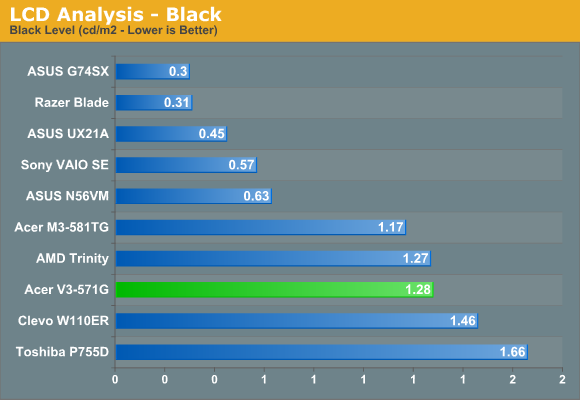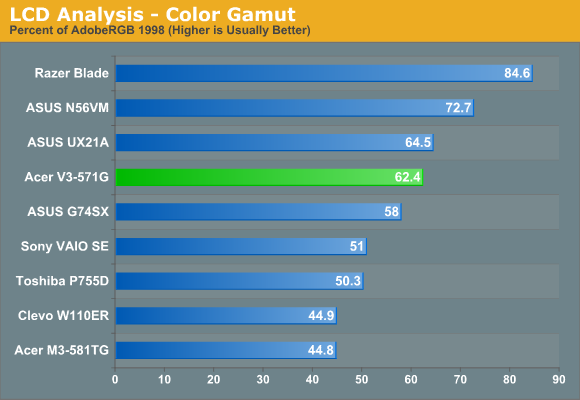Acer Aspire V3-571G-9435: The Value Proposition
by Jarred Walton on July 4, 2012 4:25 AM ESTAcer V3-571G: Just How Bad Is the LCD?
We’ve made it a habit of pointing out just how bad a lot of laptop LCDs are, and sadly (but not surprisingly) Acer’s V3 laptop does nothing to buck the trend. We’re not even hoping for something like Apple’s Retina MacBook Pro here; I’d setting for just getting a better resolution than 1366x768 on a 15.6” display, and improved contrast would be icing on the cake. The LG LP156WH4 panel sadly provides neither. First, let’s see the results.





You get very poor contrast, poor maximum brightness, and weak colors. Note that we’re reporting color accuracy after calibration—run any of the laptops without using calibration software and hardware and you’ll get a Delta E consistently in the 15-25 range. (That might seem horrible, and it is, but it’s basically the same thing you get with every single tablet right now so keep that in mind.) Viewing angles are also really poor, with massive color shifting when you view the display from above or below.
But Can You Do Anything About It?
With all the bad aspects of the LCD, I got thinking: can you replace the panel with something better? As luck would have it, I have one of my favorite LCDs from the past several years ready for just such a test, the AU Optronics B156HW01v4. This particular panel comes courtesy of LaptopScreen.com, and you can even purchase your own for just $86 right now. (The original LP156WH4 costs $65, if you’re curious—and LaptopScreens has it in glossy and matte variants if you’re interested; the B156HW01 v7 is the glossy equivalent of the v4 as well, if you prefer glossy.)
I have to say, having had two cracked LCDs on laptops during the past five or so years, the improved availability of replacements (at very reasonable prices!) is definitely welcome. Even better news: the B156HW01 fits perfectly into the Acer V3 chassis. You can see the disassembly process in the following gallery—I used an old credit card to help pry the plastic chassis apart.
That’s all great news, but sadly there’s not a happy ending to this particular story. Despite a rather complex disassembly process (and the very real potential to break off some plastic clips), even though everything fits the final result was a failure. The original display is a budget 1366x768 panel, and as best I can tell Acer uses a data cable that doesn’t support higher resolutions properly. With the B156HW01 installed, you can boot up the laptop without trouble and even select the 1920x1080 resolution within Windows, but every other column of pixels ends up being white.
Update: The technical explanation is that, much like single-link DVI vs. dual-link DVI, there are single-channel LVDS cables and dual-channel LVDS cables. Single-channel LVDS can support up to 1366x768 (1280x800), but anything beyond that requires dual-channel LVDS. That means if you get a laptop with a 1600x900 display, you can upgrade to 1080p without needing a different cable, but for laptops like the V3 that ship with a native 1366x768 panel you will likely need a different cable. The single-channel LVDS cables have eight missing (empty) wires for the second data channel, which is why every other column ended up blank. Unfortunately, I haven't had any luck finding a compatible cable for the newly launch V3-571G. If you're feeling really adventurous, you could always try to roll your own.
If you can find an appropriate data/power cable, you should be able to get the 1080p display to work properly, but I have to send this laptop back to Acer so I’m not going to spend any more effort on the attempt. In general, you should be able to replace an LCD in a laptop with any LCD that runs at the same or lower resolution (and has the same form factor—note that there are at least four different form factors/mounting mechanisms just for 15.6” screens), but for higher resolution displays you will need a laptop that is designed to support such displays. If you buy a laptop where the manufacturer supports multiple resolutions (e.g. Dell’s XPS 15z can be configured with either a 1366x768 or a 1920x1080 display), you should be able to make the upgrade as well, but ideally you’d just buy a laptop with a quality display in the first place.
When I see 1920x1200 tablets from ASUS and Acer hitting the market, or ASUS’ 1080p Ultrabooks—not to mention Apple pushing their Retina displays on all of their product lines—I keep thinking, “Maybe we’re finally going to see the end of low resolution displays.” After all, go shopping for a new HDTV and you’ll see that no one even bothers with 720p these days and the only HDTVs that aren’t 1080p (or higher) are on clearance. So why is it that our laptops are still stuck with such a low resolution? If you care about displays, my recommendation is to make sure to let your wallet do the talking, and encourage friends and relatives to do the same. (/rant)


_thumb.jpg)
_thumb.jpg)
_thumb.jpg)
_thumb.jpg)
_thumb.jpg)
_thumb.jpg)
_thumb.jpg)
_thumb.jpg)
_thumb.jpg)
_thumb.jpg)
_thumb.jpg)
_thumb.jpg)
_575px.jpg)








88 Comments
View All Comments
3dgeneralist - Thursday, July 5, 2012 - link
Regarding the resolution. Its also dumb to think everyone uses higher than 1440x900 res on a 15inch laptop. Can barely read the text and icons higher than that on a small screen. Even on my 23inch monitor I am using 1440x900 because I'm on it for more than 10 hours a day working on graphic software. Eye fatigue is worse when reading small fonts and images.seapeople - Thursday, July 5, 2012 - link
This has always puzzled me. Does it really help your eyes to be looking at large, fuzzy text all day (LCD non native resolution) versus looking at smaller but perfectly sharp and clear text?This is of course assuming you are unable to increase DPI due to application incompatibilities, otherwise you're just being silly.
3dgeneralist - Saturday, July 7, 2012 - link
Its not really fuzzy looking at 1440x900 with text 110% dpi and adjusting cleartype settings on my 23inch monitor. The comfort gained is huge compared to setting it to 1920x1080 which in 8 hours looking at the monitor seems like my eyes would just drop and my head hurts.Remember the less effort you put into something that should be automatic, the less strain you experience.
antef - Thursday, July 5, 2012 - link
Jarred, I will be in the market for an even cheaper laptop soon (~$600), and I'm not sure I like Dell's offerings. I hope you are able to review some even cheaper Acer machines in the near future (with Core i3/i5 CPUs, possibly no discrete graphics, etc.).Meaker10 - Thursday, July 5, 2012 - link
Much like the 5935G then, the cable connector looks like it could just support enough extra lines for a second LVDS channel but its not like the old connector where you could slot extra wires into place, it's an extremely fiddley connector and would require VERY VERY fine soldering skills. I killed a mobo trying.Thats assuming the extra spaces are for an LVDS channel and the chip on the motherboard supports two.
Kill16by9TN - Thursday, July 5, 2012 - link
"The only complaint I have is a minor one: the “merged” Enter and Backslash keys. We’ve seen this on a few Acer laptops in the past year, and I don’t know what purpose the non-gap layout serves,"The answer is probably rather simple: globalisation.
There are some keyboard layouts I know of, German for example, where 'Enter' occupies the additional space of the US KB's 'backslash', while the left-hand 'Shift' key in turn is shortened on its right side to make room for the now relocated key.
Acer's design choice therefore accommodates for US-style and European-style keyboard layouts.
BTW, I couldn't agree more with your criticism of those insane highly glossy 'piano' finish surfaces, no matter if with laptops/notebooks or monitors/TVs. It just majorly sucks. When will this nonsense finally face extinction?
Burticus - Thursday, July 5, 2012 - link
My A8-3500 Gateway 17" was $550 with blu-ray 7 months ago. Spent $20 to get it up to 8gb 1333. Nothing in that price range can touch it. On the other hand, while it doesn't weigh a ton it is pretty big. Trinity is faster and the same price or cheaper. I think the display on it is pretty decent for 1600x900 but it does have some contrast issues. Those only come into play when watching dark movies though: which my wife does constantly and complains constantly. I told her to buy her own laptop if she didn't like mine :-)This is interesting for budget power with that i7 and the Kepler video, but it seems an odd compromise... you would think someone would go down $200 to get Trinity, or go up $200 to get something a little better build quality and better display. I don't think you can score an ultrabook for a grand though (and those don't have optical drives which slays me).
karasaj - Thursday, July 5, 2012 - link
Assuming there aren't any major major compromises, you can get an Acer TimelineU M5 for a pretty nice 800$.Piss poor screen though, which might be the biggest compromise that is probably a dealbreaker for some. I would consider it though since it's so much less expensive than other ultrabooks (or thin form factor specs) like the Vaio S and Vizio. Or SS7. And build quality is hopefully more ultrabookish and less Aspire V3ish.
Ipatinga - Thursday, July 5, 2012 - link
When you thought manufacturers couldn´t screw you more... you face a "chiclet" keyboard everywhere.Damn... do engineers really use what they make? (Yeah, dumb question...) :P
PubFiction - Friday, July 6, 2012 - link
There seems to be some sort of stupid idea that chiclet keys are better.The form a key has nothing to do with its quality, in fact chiclet keys are most known for being implemented in cheap shit. The physical properties are what make a keyboard good or bad regardless of weather it is chiclet, island or anything.
Most chiclet keys are not as good as the keyboards they replaced, they are mushy, unresponsive and are flat lacking qualities designed for accuracy.
It is fine if you prefer chiclet, go ahead and state that but done gloss over all the other properties. The pictures clearly show that these keyboard is flat, lacking the concave nature or a real good keyboard.
You can also see that this keyboard exposes the underside of the keys slightly meaning things can easily get in there such as crumbs dust and such, wholely defeating one of the biggest advantages of chiclet. The spacing appears to be close which means that you are likely to trigge another key if you miss.
Finally there is not mention of the quality of key rollover.